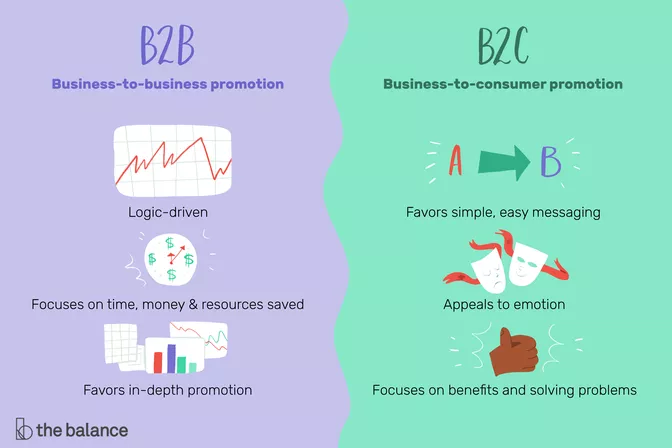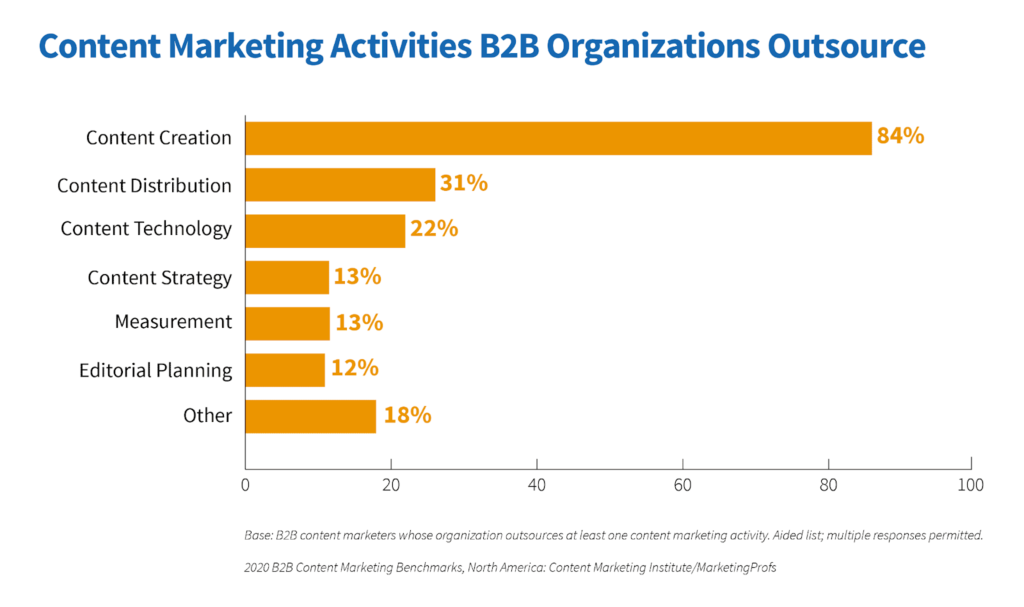B2B Content Marketing Tips: Create a Successful Marketing Budget in 2022

Table of Contents
- What is B2B Marketing?
- How to Set Up a Content Marketing Budget
- What Comprises a B2B Marketing Budget?
- Key Takeaways
- Conclusion
- FAQs
Effective marketing is essential to achieve your business goals. Marketers have to take care of several parameters when creating a marketing campaign. These include creative demands, budget constraints, employee capacity, channel decisions, and more.
The most important determinant of effective marketing is your audience. If you don’t appropriately target your buyer persona, your promotions and advertisements will most likely go unnoticed. You might be better off not marketing at all. On the other hand, individual consumers and businesses have vastly different target audiences. Some businesses cater to individual customers, while others cater to businesses and organisations.
Marketing to businesses is not the same as marketing to individual consumers. That is why there is an entirely different branch of marketing called B2B Marketing. In fact, B2B marketing is growing exponentially. As per Content Marketing Institute, almost 65% of B2B marketers say their current overall content marketing success has increased compared to a year ago.
This article will help you understand what B2B Marketing is and create the proper B2B marketing budget for your business. So, let’s dive in to know about some of the best B2B content marketing tips!

What is B2B Marketing?
Before we get into marketing budgets and B2B content marketing tips, it is important to understand what B2B marketing is. B2B marketing is short for business-to-business marketing. Rather than marketing directly to consumers, brands create marketing campaigns to target other businesses.
When a company decides to sell its services or products to another business, it develops a B2B marketing plan or strategy. The messaging in a B2B marketing strategy is fairly different because your prospective buyer is a business and not an individual. When an organization thinks about purchasing another company’s product, it may look for content explicitly tailored to its interests or needs. This can include thought-leadership content, return-on-investment data, product pricing, and more.
B2B marketing vs. B2C marketing
Because each marketing method tailors its strategy to a specific audience, it is easy to confuse the two. B2B marketing’s primary target audience is other businesses, whereas B2C marketing messaging focuses directly on consumers. A company that buys software for its employees, for example, would be considered a B2B company. A B2B marketing audience could include people in management or leadership roles who make financial decisions for the company. When you tailor your messaging to B2B companies, you can emphasize both the financial benefits of your product and how it will benefit the potential business.
An example of a company that does B2B Marketing is IBM. IBM’s customers are other businesses such as Microsoft, Dell, Oracle, etc.
The direct consumer is a B2C marketing customer. B2C marketing is exemplified by stores that sell merchandise to individuals—for example, Puma or Dominos. Because this type of marketing is targeted at a specific individual, the messaging is often more entertaining and works to meet the individual’s needs or interests.
While a B2B customer typically makes decisions based on logic, value, and analysis, a B2C audience usually makes purchase decisions based on emotional value.

Despite their differences, B2B and B2C marketing intersect in many ways.
For example, an interior design firm that creates office spaces for businesses (a B2B service) may also create specific rooms in homes for homebuyers (a B2C service). A dental care company that sells toothbrushes, toothpaste, and mouthwash to individuals (a B2C service) may also sell to dentist offices (a B2B service). The goal of both is to convert the audience into buyers through marketing campaigns that highlight the benefits of the product/ service.
How to Set Up a Content Marketing Budget
Properly defining your content marketing is important to effectively market your brand to your audience. Your content marketing budget will guide you throughout – from execution to final results.
What is a content marketing budget?
A content marketing budget is a detailed document outlining how much money your company invests in content creation, publication, and distribution. Labor, tools and technologies, design, vendors, and other expenses are included in the budget. Your content marketing budget should be developed alongside your content marketing strategy. It’s challenging to set goals if you don’t know how much money you have to invest in order to achieve them.
As per Statista, 46% of B2B companies plan on increasing their content marketing spend within the next 12 months.
Given the importance of content marketing in B2B, we have some of the best B2B content marketing tips for you.
B2B content marketing tips for setting a budget
Here are the best content marketing tips to set up a B2B budget.
- Analyze your goals
What do you hope to achieve with your content marketing efforts? Do you want to increase your page views, generate new leads, or boost your share of voice? And by how much do you want to improve these metrics?
Understanding the answers to these questions will assist you in reverse engineering your budget. You can see exactly how much money you need to spend to meet your stated goals. The best way to accomplish this is to assign a monetary value to specific outcomes, such as the worth of a page view or an ebook download. Then you can calculate how much of each metric you need to drive to generate a positive ROI.
- Evaluate your competition
Each industry has a unique content marketing landscape, with some being more competitive than others. For example, if you work in the B2B SaaS space, you’ll almost certainly need a sizable content marketing budget to generate value because the competition is fierce.
This is why, when planning your budget, we recommend auditing your competitors. You’ll know the quantity, quality, format, and focus of content you need to create if you look at what your competitors are doing.
- Make the most of the budget you have
If your goal is to increase your budget every year, you must demonstrate that you have maximized the use of your current budget. When you realize that 70% of the content created by B2B content marketers never sees the light of day, you need to conduct a thorough audit of your content strategy.
Concentrate on producing higher-quality content that can be used, repurposed, and reused. Keep track of the effectiveness of your content. Remove a particular content piece if you discover that it isn’t performing well.
With these content marketing budget tips in mind, you’re one step ahead in setting up the right content marketing budget for your business.
What Comprises a B2B Marketing Budget?
A content marketing budget comprises five key components. This section will see what these components are and what a typical budget breakdown looks like.
1. Content planning and creation: 40-50%
Before you begin creating content for your marketing campaign, you must determine your campaign objectives. When your campaign is over, you can evaluate the returns on your marketing investments through these objectives.
Assume, for example, that your goal is to familiarize other businesses with your brand name. Your content creation efforts should focus on thought-leadership content, extensive guides, newsletters, etc., to achieve this goal.
Whatever goal you’ve set for yourself, the content will most likely be critical to your success.
2. Content planning and creation: 40-50%
Paid advertising is, of course, a very important part of your content marketing budget. In most cases, you cannot solely rely on organic content to achieve your goals. Paid advertising includes Facebook Ads, Google Ads, Email Marketing, etc.
If your company is entering a new market in your industry targeting a different customer segment or persona, paid advertising can be especially effective in helping your brand improve awareness and presence in that market.
Before you start paid advertising, you should conduct some preliminary research. This is where your content marketing strategy comes into play. You must sketch out details about your target audience – their pain points, what kind of content they consume, etc.
Once you have those insights, you can decide which paid channels are the best for you. And based on parameters such as the scale of your campaign and marketing goal, you can choose how much you want to spend. For example, you would spend more on a campaign to drive sales than to raise awareness.
3. Building capacity/upskilling: 10-15%
Reserve a part of your content marketing budget for hiring and upskilling purposes.
You will need to outsource some part of your market or hire a professional more often than not. This is especially true for businesses that do not have an in-house marketing team.

Content creation is one vertical in marketing that businesses have increasingly outsourced. With the freelance economy growing exponentially, it allows businesses to get quality work at affordable rates.
4. Marketing technologies: 10%
Finally, marketing technologies take up a part of your content marketing budget.
Marketing technologies can significantly improve the efficiency of automating, administering, tracking and analyzing your marketing activities. These tools can not only save you time, money, and resources, but they can also give you the information and metrics you need to review and optimise your campaigns. This allows you to show and improve your marketing ROI more successfully.
Before you begin any campaigns, ensure that you have a measurement strategy to track the metrics you need to analyse campaign performance correctly. Also, ensure you have the resources to support your measurement needs.
These are the primary elements of a content marketing budget. The budget breakdown might vary from business to business.
Key Takeaways
- B2B marketing is short for business-to-business marketing. Rather than marketing directly to consumers, brands create marketing campaigns to target other businesses.
- B2B marketing’s primary target audience is other businesses, whereas B2C marketing’s messaging is aimed directly at consumers.
- Defining your content marketing budget correctly is important to market to your audience effectively. Your content marketing budget will guide you throughout – from execution to final results.
- Three B2B content marketing tips to set up a content marketing budget are – analyzing your goals, evaluating your competition, and making the most of the budget you have.
- The typical breakdown of a B2B content marketing budget is – content planning and creation: 40-50%, paid advertising: 20-30%, building capacity/upskilling: 10-15%, and marketing technologies: 10%.
FAQs
B2B marketing is short for business-to-business marketing. Rather than marketing directly to consumers, brands create marketing campaigns to target other businesses. When a company decides to sell its services or products to another company, it develops a B2B marketing plan or strategy. In a B2B marketing strategy, you may speak to business audiences differently than you would to a consumer audience.
B2B marketing’s primary target audience is other businesses, whereas B2C marketing messaging is aimed directly at consumers. Longer customer connections are more common in B2B. In B2C, customer connections are typically shorter, and clients are less committed.
Marketing can improve B2B sales by helping you effectively target the right businesses for your product/service. It opens up many avenues for you through both organic and paid media.
You can utilize similar approaches as B2C marketing, but you must put a lot of thought into the USP of your product/service. You must clearly lay out the value addition of your product for the businesses you are targeting.
A content marketplace, such as Pepper Content, selling its services to businesses that need help with content marketing, is an example of B2B marketing.
Latest Blogs
Explore how Google’s 2025 AI search updates triggered ranking chaos. Learn actionable strategies to adapt your SEO for AI Overviews, zero-click searches, and SERP volatility. Stay ahead now.
Learn how to rank on AI search engines like ChatGPT, Perplexity, and Gemini by optimizing your content for authority, structure, and relevance. Stay ahead in AI-driven search with this strategic guide.
Explore the best healthcare SEO services for your medical practice. Improve online visibility and effectively reach more patients in need of your services.
Get your hands on the latest news!
Similar Posts

Content Marketing
4 mins read
11 Best B2B Content Marketing Agencies for B2B Companies in 2024

Content Marketing
5 mins read
Top ecommerce Marketing Agencies with Proven Strategies for 2024

Content Marketing
5 mins read